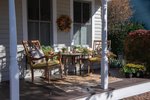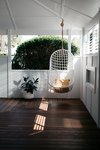



Our country home
Warm weather invites us to get out and enjoy the natural world—and what better way to appreciate the balmy days of late summer than spending them on a porch?
No matter what the style, a porch is designed to extend the living space of a home, functioning as an outdoor room while keeping you connected to nature. But more than just an outdoor room, the porch—usually located in the front, facing the street—defines the character of the house. The front porch also serves as an entrance, the perfect place to welcome visitors or exchange greetings with friends and neighbors.
The late 1950s and 1960s, with the advent of television and air-conditioning, saw the decline of the porch from its prominent place in American culture. Modern home plans no longer included the porch; instead, homeowners began building backyard decks and patios.
But recent decades have seen a revival of porch-building. The classic image of a front porch filled with family and friends on a hot summer evening has long been a symbol of traditional American life. Front porches are now being added to existing homes and once again appearing on new house plans.
Today the front porch—especially since the beginning of COVID—has become the popular gathering place for family and friends, whatever the weather.
Whether small or large, a comfortable porch can be a favorite gathering spot, rain or shine, a place to kick off our shoes and relax, and serve as an antidote to our high-stress world. But just because the porch is a place to relax doesn’t mean its decor should be subdued.
Accessories are a great way to add color to your outdoor room. Colorful planters, indoor/outdoor area rugs, lighting, birdhouses, lanterns, gnomes, sculpture, ceiling fans, hammocks and vine-covered trellises can embellish any porch.
Furnishings such as rocking chairs (new or antique) are especially popular for whiling away summer evenings. Favorite furnishings also include the classic porch swing, suspended on chains at one end of the porch, or the two-seated glider.
Porch furnishings can also be utilitarian, such as tables made of wood, plastic, metal or glass, and straight-backed chairs from inside.
Of course, you can always rely on furniture designed specially for the porch, made from natural wicker, resin or bamboo, with or without cushions. Popular pieces also include metal sofas and chairs covered in brightly colored and patterned outdoor upholstery.
Why do so many homeowners paint the porch ceiling blue?What started out as a Southern tradition is now a trend throughout the country. Blue porch ceilings first appeared at antebellum plantations in the early 19th century, due to the tradition of the Gullah people, enslaved African Americans in the coastal areas of Georgia and South Carolina. Gullah folklore held that ghosts—known as “haints” (and pronounced “haunts”) in the Creole dialect—could not cross water, and because blue resembles water, ceilings were painted this color to repel evil spirits. To this day, a range of pale blue-green hues is collectively known as “haint blue.” Many legends also state that blue ceilings will keep bugs at bay, that the ceiling keeps wasps and bees from building nests. Perhaps they believe the ceiling is sky, and so they will avoid the porch area. Others say the blue ceiling extends the daylight hours: Having a blue sky on the porch ceiling as the sky outside is growing dark, they believe, will make the daylight appear to stay around a bit longer. Most homeowners choose to paint the porch ceiling blue because it is a calming color, and using it in a place meant for relaxation makes sense. |
Related stories

Comments
No comments on this item Please log in to comment by clicking here